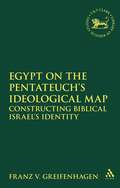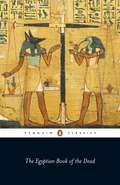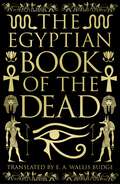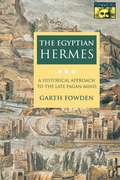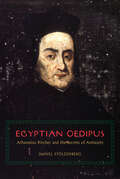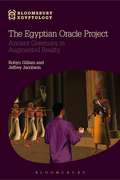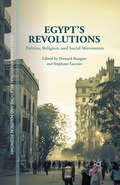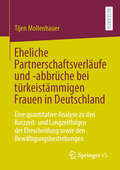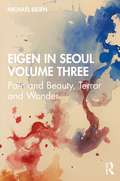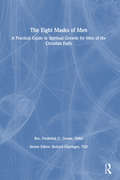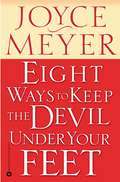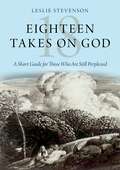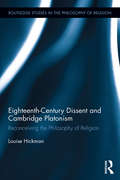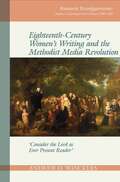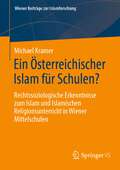- Table View
- List View
Egypt on the Pentateuch's Ideological Map: Constructing Biblical Israel's Identity (The Library of Hebrew Bible/Old Testament Studies)
by Franz V. GreifenhagenThis book explores the references to Egypt in the Pentateuch--twice as dense as in the rest of the Hebrew Bible--in the context of the production of the text's final form during the Persian period. Here, as Greifenhagen shows, Egypt functions ideologically as the primary "other" over against which Israel's identity is constructed, while its role in Israel's formation appears as subsidiary and as a superseded stage in a master narrative which locates Israel's ethnic roots in Mesopotamia. But the presentation of this powerful neighbour is equivocal: a dominant anti-Egyptian stance coexists with alternative, though subordinate, pro-Egyptian views, suggesting that the Pentateuchal narrative was produced within a context of ideological conflict over attitudes towards a land that provided a home for Jewish fugitives and emigrants.
The Egyptian Book of the Dead: The Papyrus Of Ani (Mini Albums Ser.)
by E.A. Wallis Budge John RomerThe Book of the Dead is a unique collection of funerary texts from a wide variety of sources, dating from the fifteenth to the fourth century BC. Consisting of spells, prayers and incantations, each section contains the words of power to overcome obstacles in the afterlife. The papyruses were often left in sarcophagi for the dead to use as passports on their journey from burial, and were full of advice about the ferrymen, gods and kings they would meet on the way. Offering valuable insights into ancient Egypt, The Book of the Dead has also inspired fascination with the occult and the afterlife in recent years.
Egyptian Book of the Dead
by EA Wallis BudgeThis ancient funerary text contains a collection of spells, prayers and incantations designed to guide the departed through the perils of the underworld. Written to ensure eternal life, these scrolls were often left in the sarcophagus of the deceased and now offer fascinating insight into Egyptian culture.This beautifully illustrated edition contains images from the exquisite Papyrus of Ani, an ancient Egyptian scroll narrating the journey of Theban scribe Ani through the underworld. Its accompanying hieroglyphic text has been translated by acclaimed Egyptologist E.A Wallis Budge, and includes spells addressed to ferryman, gods and kings to aid Ani on his way to the afterlife.
The Egyptian Hermes: A Historical Approach to the Late Pagan Mind
by Garth FowdenSage, scientist, and sorcerer, Hermes Trismegistus was the culture-hero of Hellenistic and Roman Egypt. A human (according to some) who had lived about the time of Moses, but now indisputably a god, he was credited with the authorship of numerous books on magic and the supernatural, alchemy, astrology, theology, and philosophy. Until the early seventeenth century, few doubted the attribution. Even when unmasked, Hermes remained a byword for the arcane. Historians of ancient philosophy have puzzled much over the origins of his mystical teachings; but this is the first investigation of the Hermetic milieu by a social historian. Starting from the complex fusions and tensions that molded Graeco-Egyptian culture, and in particular Hermetism, during the centuries after Alexander, Garth Fowden goes on to argue that the technical and philosophical Hermetica, apparently so different, might be seen as aspects of a single "way of Hermes." This assumption that philosophy and religion, even cult, bring one eventually to the same goal was typically late antique, and guaranteed the Hermetica a far-flung readership, even among Christians. The focus and conclusion of this study is an assault on the problem of the social milieu of Hermetism.
Egyptian Oedipus: Athanasius Kircher and the Secrets of Antiquity
by Daniel StolzenbergA contemporary of Descartes and Newton, Athanasius Kircher, S. J. (1601/2–80), was one of Europe’s most inventive and versatile scholars in the baroque era. He published more than thirty works in fields as diverse as astronomy, magnetism, cryptology, numerology, geology, and music. But Kircher is most famous—or infamous—for his quixotic attempt to decipher the Egyptian hieroglyphs and reconstruct the ancient traditions they encoded. In 1655, after more than two decades of toil, Kircher published his solution to the hieroglyphs, Oedipus Aegyptiacus, a work that has been called “one of the most learned monstrosities of all times.” Here Daniel Stolzenberg presents a new interpretation of Kircher’s hieroglyphic studies, placing them in the context of seventeenth-century scholarship on paganism and Oriental languages. Situating Kircher in the social world of baroque Rome, with its scholars, artists, patrons, and censors, Stolzenberg shows how Kircher’s study of ancient paganism depended on the circulation of texts, artifacts, and people between Christian and Islamic civilizations. Along with other participants in the rise of Oriental studies, Kircher aimed to revolutionize the study of the past by mastering Near Eastern languages and recovering ancient manuscripts hidden away in the legendary libraries of Cairo and Damascus. The spectacular flaws of his scholarship have fostered an image of Kircher as an eccentric anachronism, a throwback to the Renaissance hermetic tradition. Stolzenberg argues against this view, showing how Kircher embodied essential tensions of a pivotal phase in European intellectual history, when pre-Enlightenment scholars pioneered modern empirical methods of studying the past while still working within traditional frameworks, such as biblical history and beliefs about magic and esoteric wisdom.
Egyptian Oedipus: Athanasius Kircher and the Secrets of Antiquity
by Daniel StolzenbergA contemporary of Descartes and Newton, Athanasius Kircher, S. J. (1601/2–80), was one of Europe’s most inventive and versatile scholars in the baroque era. He published more than thirty works in fields as diverse as astronomy, magnetism, cryptology, numerology, geology, and music. But Kircher is most famous—or infamous—for his quixotic attempt to decipher the Egyptian hieroglyphs and reconstruct the ancient traditions they encoded. In 1655, after more than two decades of toil, Kircher published his solution to the hieroglyphs, Oedipus Aegyptiacus, a work that has been called “one of the most learned monstrosities of all times.” Here Daniel Stolzenberg presents a new interpretation of Kircher’s hieroglyphic studies, placing them in the context of seventeenth-century scholarship on paganism and Oriental languages. Situating Kircher in the social world of baroque Rome, with its scholars, artists, patrons, and censors, Stolzenberg shows how Kircher’s study of ancient paganism depended on the circulation of texts, artifacts, and people between Christian and Islamic civilizations. Along with other participants in the rise of Oriental studies, Kircher aimed to revolutionize the study of the past by mastering Near Eastern languages and recovering ancient manuscripts hidden away in the legendary libraries of Cairo and Damascus. The spectacular flaws of his scholarship have fostered an image of Kircher as an eccentric anachronism, a throwback to the Renaissance hermetic tradition. Stolzenberg argues against this view, showing how Kircher embodied essential tensions of a pivotal phase in European intellectual history, when pre-Enlightenment scholars pioneered modern empirical methods of studying the past while still working within traditional frameworks, such as biblical history and beliefs about magic and esoteric wisdom.
Egyptian Oedipus: Athanasius Kircher and the Secrets of Antiquity
by Daniel StolzenbergA contemporary of Descartes and Newton, Athanasius Kircher, S. J. (1601/2–80), was one of Europe’s most inventive and versatile scholars in the baroque era. He published more than thirty works in fields as diverse as astronomy, magnetism, cryptology, numerology, geology, and music. But Kircher is most famous—or infamous—for his quixotic attempt to decipher the Egyptian hieroglyphs and reconstruct the ancient traditions they encoded. In 1655, after more than two decades of toil, Kircher published his solution to the hieroglyphs, Oedipus Aegyptiacus, a work that has been called “one of the most learned monstrosities of all times.” Here Daniel Stolzenberg presents a new interpretation of Kircher’s hieroglyphic studies, placing them in the context of seventeenth-century scholarship on paganism and Oriental languages. Situating Kircher in the social world of baroque Rome, with its scholars, artists, patrons, and censors, Stolzenberg shows how Kircher’s study of ancient paganism depended on the circulation of texts, artifacts, and people between Christian and Islamic civilizations. Along with other participants in the rise of Oriental studies, Kircher aimed to revolutionize the study of the past by mastering Near Eastern languages and recovering ancient manuscripts hidden away in the legendary libraries of Cairo and Damascus. The spectacular flaws of his scholarship have fostered an image of Kircher as an eccentric anachronism, a throwback to the Renaissance hermetic tradition. Stolzenberg argues against this view, showing how Kircher embodied essential tensions of a pivotal phase in European intellectual history, when pre-Enlightenment scholars pioneered modern empirical methods of studying the past while still working within traditional frameworks, such as biblical history and beliefs about magic and esoteric wisdom.
Egyptian Oedipus: Athanasius Kircher and the Secrets of Antiquity
by Daniel StolzenbergA contemporary of Descartes and Newton, Athanasius Kircher, S. J. (1601/2–80), was one of Europe’s most inventive and versatile scholars in the baroque era. He published more than thirty works in fields as diverse as astronomy, magnetism, cryptology, numerology, geology, and music. But Kircher is most famous—or infamous—for his quixotic attempt to decipher the Egyptian hieroglyphs and reconstruct the ancient traditions they encoded. In 1655, after more than two decades of toil, Kircher published his solution to the hieroglyphs, Oedipus Aegyptiacus, a work that has been called “one of the most learned monstrosities of all times.” Here Daniel Stolzenberg presents a new interpretation of Kircher’s hieroglyphic studies, placing them in the context of seventeenth-century scholarship on paganism and Oriental languages. Situating Kircher in the social world of baroque Rome, with its scholars, artists, patrons, and censors, Stolzenberg shows how Kircher’s study of ancient paganism depended on the circulation of texts, artifacts, and people between Christian and Islamic civilizations. Along with other participants in the rise of Oriental studies, Kircher aimed to revolutionize the study of the past by mastering Near Eastern languages and recovering ancient manuscripts hidden away in the legendary libraries of Cairo and Damascus. The spectacular flaws of his scholarship have fostered an image of Kircher as an eccentric anachronism, a throwback to the Renaissance hermetic tradition. Stolzenberg argues against this view, showing how Kircher embodied essential tensions of a pivotal phase in European intellectual history, when pre-Enlightenment scholars pioneered modern empirical methods of studying the past while still working within traditional frameworks, such as biblical history and beliefs about magic and esoteric wisdom.
Egyptian Oedipus: Athanasius Kircher and the Secrets of Antiquity
by Daniel StolzenbergA contemporary of Descartes and Newton, Athanasius Kircher, S. J. (1601/2–80), was one of Europe’s most inventive and versatile scholars in the baroque era. He published more than thirty works in fields as diverse as astronomy, magnetism, cryptology, numerology, geology, and music. But Kircher is most famous—or infamous—for his quixotic attempt to decipher the Egyptian hieroglyphs and reconstruct the ancient traditions they encoded. In 1655, after more than two decades of toil, Kircher published his solution to the hieroglyphs, Oedipus Aegyptiacus, a work that has been called “one of the most learned monstrosities of all times.” Here Daniel Stolzenberg presents a new interpretation of Kircher’s hieroglyphic studies, placing them in the context of seventeenth-century scholarship on paganism and Oriental languages. Situating Kircher in the social world of baroque Rome, with its scholars, artists, patrons, and censors, Stolzenberg shows how Kircher’s study of ancient paganism depended on the circulation of texts, artifacts, and people between Christian and Islamic civilizations. Along with other participants in the rise of Oriental studies, Kircher aimed to revolutionize the study of the past by mastering Near Eastern languages and recovering ancient manuscripts hidden away in the legendary libraries of Cairo and Damascus. The spectacular flaws of his scholarship have fostered an image of Kircher as an eccentric anachronism, a throwback to the Renaissance hermetic tradition. Stolzenberg argues against this view, showing how Kircher embodied essential tensions of a pivotal phase in European intellectual history, when pre-Enlightenment scholars pioneered modern empirical methods of studying the past while still working within traditional frameworks, such as biblical history and beliefs about magic and esoteric wisdom.
Egyptian Oedipus: Athanasius Kircher and the Secrets of Antiquity
by Daniel StolzenbergA contemporary of Descartes and Newton, Athanasius Kircher, S. J. (1601/2–80), was one of Europe’s most inventive and versatile scholars in the baroque era. He published more than thirty works in fields as diverse as astronomy, magnetism, cryptology, numerology, geology, and music. But Kircher is most famous—or infamous—for his quixotic attempt to decipher the Egyptian hieroglyphs and reconstruct the ancient traditions they encoded. In 1655, after more than two decades of toil, Kircher published his solution to the hieroglyphs, Oedipus Aegyptiacus, a work that has been called “one of the most learned monstrosities of all times.” Here Daniel Stolzenberg presents a new interpretation of Kircher’s hieroglyphic studies, placing them in the context of seventeenth-century scholarship on paganism and Oriental languages. Situating Kircher in the social world of baroque Rome, with its scholars, artists, patrons, and censors, Stolzenberg shows how Kircher’s study of ancient paganism depended on the circulation of texts, artifacts, and people between Christian and Islamic civilizations. Along with other participants in the rise of Oriental studies, Kircher aimed to revolutionize the study of the past by mastering Near Eastern languages and recovering ancient manuscripts hidden away in the legendary libraries of Cairo and Damascus. The spectacular flaws of his scholarship have fostered an image of Kircher as an eccentric anachronism, a throwback to the Renaissance hermetic tradition. Stolzenberg argues against this view, showing how Kircher embodied essential tensions of a pivotal phase in European intellectual history, when pre-Enlightenment scholars pioneered modern empirical methods of studying the past while still working within traditional frameworks, such as biblical history and beliefs about magic and esoteric wisdom.
The Egyptian Oracle Project: Ancient Ceremony in Augmented Reality (Bloomsbury Egyptology)
by Robyn Gillam Jeffrey JacobsonFor more than 2,000 years, between 1500 BCE and 600 CE, the Egyptian processional oracle was one of the main points of contact between temple-based religion and the general population. In a public ceremony, a god would indicate its will or answer questions through the movements of a portable cult statue borne by priests or important members of the community.The Egyptian Oracle Project is an interactive performance that adapts this ceremony to serve as the basis for a mixed-reality educational experience for children and young adults, using both virtual reality and live performance. The scene is set in a virtual Egyptian temple projected onto a wall. An oracle led by a high priest avatar (controlled by a live human puppeteer) is brought into the presence of a live audience, who act in the role of the Egyptian populace. Through the mediation of an actress, the audience interacts with the avatar, recreating the event.The series of carefully focused essays in this book provides vital background to this path-breaking project in three sections. After a brief introduction to educational theatre and virtual reality, the first section describes the ancient ceremony and its development, along with cross-cultural connections. Then the development of the script and its performance in the context of mixed-reality and educational theatre are examined. The final set of essays describes the virtual temple setting in more detail and explores the wider implications of this project for virtual heritage.
The Egyptian Oracle Project: Ancient Ceremony in Augmented Reality (Bloomsbury Egyptology)
by Robyn Gillam Jeffrey JacobsonFor more than 2,000 years, between 1500 BCE and 600 CE, the Egyptian processional oracle was one of the main points of contact between temple-based religion and the general population. In a public ceremony, a god would indicate its will or answer questions through the movements of a portable cult statue borne by priests or important members of the community.The Egyptian Oracle Project is an interactive performance that adapts this ceremony to serve as the basis for a mixed-reality educational experience for children and young adults, using both virtual reality and live performance. The scene is set in a virtual Egyptian temple projected onto a wall. An oracle led by a high priest avatar (controlled by a live human puppeteer) is brought into the presence of a live audience, who act in the role of the Egyptian populace. Through the mediation of an actress, the audience interacts with the avatar, recreating the event.The series of carefully focused essays in this book provides vital background to this path-breaking project in three sections. After a brief introduction to educational theatre and virtual reality, the first section describes the ancient ceremony and its development, along with cross-cultural connections. Then the development of the script and its performance in the context of mixed-reality and educational theatre are examined. The final set of essays describes the virtual temple setting in more detail and explores the wider implications of this project for virtual heritage.
Egypt's Revolutions: Politics, Religion, and Social Movements (The Sciences Po Series in International Relations and Political Economy)
by Stéphane Lacroix Bernard Rougier Cynthia Schoch John AngellWhere is Egypt headed? Did the people 'bring down the government'? Has the country become the first front in a regional counter-revolution backed by the Gulf monarchies? These are only some of the questions that this volume - the first to describe the ongoing dynamics in Egypt since the outbreak of revolution - explores.
Eheliche Partnerschaftsverläufe und -abbrüche bei türkeistämmigen Frauen in Deutschland: Eine quantitative Analyse zu den Kurzzeit- und Langzeitfolgen der Ehescheidung sowie den Bewältigungsbestrebungen
by Tijen MollenhauerMit ihrer retrospektiv angelegten quantitativen Studie zum Verlauf der Scheidungs- und Nachscheidungsphase türkeistämmiger Migrantinnen bedient Tijen Mollenhauer ein Desiderat sowohl der bisher kaum mit der geschlechterspezifischen Rolle geschiedener (türkeistämmiger) Migranten befassten Migrationsforschung als auch der kulturelle und ethnische Heterogenität weitgehend ausklammernden Scheidungsforschung. Fokussiert auf Unterschiede zwischen in Deutschland sozialisierten Frauen und Heiratsmigrantinnen zielt ihre Arbeit auf die scheidungsbedingten Kurzzeit- und Langzeitfolgen, die seitens der Frauen gewählten Bewältigungsbestrebungen sowie diesbezügliche Einflussfaktoren.
Eigen in Seoul Volume Three: Pain and Beauty, Terror and Wonder
by Michael EigenBetween 2007 and 2011, Michael Eigen gave three seminars in Seoul, each running over three days and covering different aspects of psychoanalysis, spirituality and the human psyche. This book is based on a transcription of the third seminar, which took place in 2011, on the subject of Pain and Beauty. The first two were published as Madness and Murder (2010) and Faith and Transformation (2011). A conjunction of the pain that shatters and beauty that heals is made by many authors, including Bion, Winnicott, Milner, Meltzer, Perls, Ehrenzweig, Matte-Blanco, Schneur Zalman, Chuang-Tzu, Buber, Castaneda, and Levinas. These and others are used as windows of the psyche, adding to possibilities of experience and opening dimensions that bring us life. Eigen explores challenges of the human psyche, what we are up against and the resources difficulties can stimulate. This work spans many dimensions of human experience with interplay, fusions and oppositions of pain, beauty, terror, and wonder, and makes use of poetic and philosophical expressions of experience. It will be vital reading for psychoanalysts, psychotherapists, and all those with an interest in psychoanalytic and spiritual psychology.
Eigen in Seoul Volume Three: Pain and Beauty, Terror and Wonder
by Michael EigenBetween 2007 and 2011, Michael Eigen gave three seminars in Seoul, each running over three days and covering different aspects of psychoanalysis, spirituality and the human psyche. This book is based on a transcription of the third seminar, which took place in 2011, on the subject of Pain and Beauty. The first two were published as Madness and Murder (2010) and Faith and Transformation (2011). A conjunction of the pain that shatters and beauty that heals is made by many authors, including Bion, Winnicott, Milner, Meltzer, Perls, Ehrenzweig, Matte-Blanco, Schneur Zalman, Chuang-Tzu, Buber, Castaneda, and Levinas. These and others are used as windows of the psyche, adding to possibilities of experience and opening dimensions that bring us life. Eigen explores challenges of the human psyche, what we are up against and the resources difficulties can stimulate. This work spans many dimensions of human experience with interplay, fusions and oppositions of pain, beauty, terror, and wonder, and makes use of poetic and philosophical expressions of experience. It will be vital reading for psychoanalysts, psychotherapists, and all those with an interest in psychoanalytic and spiritual psychology.
The Eight Masks of Men: A Practical Guide in Spiritual Growth for Men of the Christian Faith
by Frederick Grosse Richard L DayringerIn today's rapidly changing society, the rules you learned as a child may no longer apply, causing you to experience restlessness and confusion. The Eight Masks of Men: A Practical Guide in Spiritual Growth for Men of the Christian Faith will encourage you to come out from behind your mask of solitude and loneliness--one of man's most obtrusive masks--and reach out for help and community. By answering questions commonly asked by men of various religious and personal backgrounds, this book will help you tune into your feelings, innermost thoughts, and that void you feel inside. As you become consciously aware of how the eight masks are a part of your being, you will recognize the true gift beneath each one.The Eight Masks of Men is the first book to combine historical, theological, and sociological perspectives with a practical approach for personal growth. To help you divest yourself of your inhibitions and experience inner harmony, it blends personal stories, humorous anecdotes, biblical research, and clinical information. The eight masks that men wear and what they hide that author Rev. Dr. Frederick G. Grosse explores include:mask: loneliness; hides: desire for communitymask: rage and anger; hide: pain and hurtmask: compulsion; hides: desire for lovemask: performance; hides: desire for acceptancemask: control; hides: desire for friendshipmask: producing; hides: desire to just “be”mask: competition; hides: desire for humilitymask: institutional religion; hides: desire for spiritual growthDon't let tragedy or desperation strike before you commit to building a healthier relationship with yourself, the people important to you, and God. Men who feel out of touch with their spiritual sides, retreat and spiritual direction leaders, pastoral counselors, chaplains, marriage and family counselors, and members of the clergy will find in The Eight Masks of Men the inspiration and insight they need to guide themselves and one another to a season of union with God.
The Eight Masks of Men: A Practical Guide in Spiritual Growth for Men of the Christian Faith
by Frederick Grosse Richard L DayringerIn today's rapidly changing society, the rules you learned as a child may no longer apply, causing you to experience restlessness and confusion. The Eight Masks of Men: A Practical Guide in Spiritual Growth for Men of the Christian Faith will encourage you to come out from behind your mask of solitude and loneliness--one of man's most obtrusive masks--and reach out for help and community. By answering questions commonly asked by men of various religious and personal backgrounds, this book will help you tune into your feelings, innermost thoughts, and that void you feel inside. As you become consciously aware of how the eight masks are a part of your being, you will recognize the true gift beneath each one.The Eight Masks of Men is the first book to combine historical, theological, and sociological perspectives with a practical approach for personal growth. To help you divest yourself of your inhibitions and experience inner harmony, it blends personal stories, humorous anecdotes, biblical research, and clinical information. The eight masks that men wear and what they hide that author Rev. Dr. Frederick G. Grosse explores include:mask: loneliness; hides: desire for communitymask: rage and anger; hide: pain and hurtmask: compulsion; hides: desire for lovemask: performance; hides: desire for acceptancemask: control; hides: desire for friendshipmask: producing; hides: desire to just “be”mask: competition; hides: desire for humilitymask: institutional religion; hides: desire for spiritual growthDon't let tragedy or desperation strike before you commit to building a healthier relationship with yourself, the people important to you, and God. Men who feel out of touch with their spiritual sides, retreat and spiritual direction leaders, pastoral counselors, chaplains, marriage and family counselors, and members of the clergy will find in The Eight Masks of Men the inspiration and insight they need to guide themselves and one another to a season of union with God.
Eight Ways to Keep the Devil Under Your Feet
by Joyce MeyerThere are all kinds of things that threaten us, hurt us, and confuse us. The devil loves nothing more than using these things to keep us down so he can have the upper hand! But God has given us everything we need to keep the devil in his place, beginning with the Word of God. To live in victory, we must do more than know His Word-we must put it into action! Satan may attack you, but he doesn't have to defeat you. Joyce Meyer reveals eight proven ways for you to keep the devil under your feet. You'll learn how to:Remain peaceful through life's stormsBe strengthened and transformed by spending time with GodLearn to conquer negative thoughts.When you put God's Word into action amazing things will begin to happen. Master these eight ways to keep the devil under your feet and you'll experience the countless ways that God wants to bless you!
Eighteen Takes on God: A Short Guide for Those Who Are Still Perplexed
by Leslie StevensonWho is God? How should we think about the concept of God? How have religions shaped and altered various conceptions of God over time? Many use language about God which, if taken at face value, implies that he inhabits a human body (usually male) and walks and talks as we do. Yet to other traditions God is a genderless and spiritual form unconstrained by space or time. And while some people are firm in their faith in God, however conceived, many others are uncertain what they think--what they believe, what they think they know, and how much they think one can know rather than believe. Even among believers, there are many conceptions of God from different points in time and parts of the world--even within faiths. For readers who are puzzled by religion, it helps to have an entry point into this confusing range of possibilities. In this short and friendly guide, Leslie Stevenson walks the reader through eighteen conceptions of God, tracing how women and men have perceived him (or her) since the time of Abraham. As Stevenson acknowledges, there can be no such thing as a completely detached and neutral approach to this subject. Everyone has their own upbringing, life experiences, prejudices, and commitments to (or rejections of) the religious traditions they have encountered. Moreover, there are anciently-entrenched differences in different strands of Hinduism and Buddhism, as there are between and within Jewish, Christian, and Islamic monotheistic conceptions of God. By ranging over the thought of philosophers of religion like Feuerbach, Kant, Wittgenstein, Iris Murdoch, Simone Weil, Rudolf Otto, Martin Buber, and Abbe Louf, and practice of the Quakers, Stevenson unpacks difficult questions, including whether religious language refers to anything beyond human life, and whether God is a person (or an existing being of any sort), whether he changes over time, or can be spoken of at all. Drawing from his deep familiarity with religion and philosophy acquired over decades of scholarly work, Stevenson presents a richly informed and yet clear and accessible guide. Readers will come away with a profounder and more compassionate understanding of some of the varieties of experiencing or understanding the divine, a more critical grasp of their meaning, and an appreciation of how such views inspire people the world over.
Eighteen Takes on God: A Short Guide for Those Who Are Still Perplexed
by Leslie StevensonWho is God? How should we think about the concept of God? How have religions shaped and altered various conceptions of God over time? Many use language about God which, if taken at face value, implies that he inhabits a human body (usually male) and walks and talks as we do. Yet to other traditions God is a genderless and spiritual form unconstrained by space or time. And while some people are firm in their faith in God, however conceived, many others are uncertain what they think--what they believe, what they think they know, and how much they think one can know rather than believe. Even among believers, there are many conceptions of God from different points in time and parts of the world--even within faiths. For readers who are puzzled by religion, it helps to have an entry point into this confusing range of possibilities. In this short and friendly guide, Leslie Stevenson walks the reader through eighteen conceptions of God, tracing how women and men have perceived him (or her) since the time of Abraham. As Stevenson acknowledges, there can be no such thing as a completely detached and neutral approach to this subject. Everyone has their own upbringing, life experiences, prejudices, and commitments to (or rejections of) the religious traditions they have encountered. Moreover, there are anciently-entrenched differences in different strands of Hinduism and Buddhism, as there are between and within Jewish, Christian, and Islamic monotheistic conceptions of God. By ranging over the thought of philosophers of religion like Feuerbach, Kant, Wittgenstein, Iris Murdoch, Simone Weil, Rudolf Otto, Martin Buber, and Abbe Louf, and practice of the Quakers, Stevenson unpacks difficult questions, including whether religious language refers to anything beyond human life, and whether God is a person (or an existing being of any sort), whether he changes over time, or can be spoken of at all. Drawing from his deep familiarity with religion and philosophy acquired over decades of scholarly work, Stevenson presents a richly informed and yet clear and accessible guide. Readers will come away with a profounder and more compassionate understanding of some of the varieties of experiencing or understanding the divine, a more critical grasp of their meaning, and an appreciation of how such views inspire people the world over.
Eighteenth-Century Dissent and Cambridge Platonism: Reconceiving the Philosophy of Religion (Routledge Studies in the Philosophy of Religion)
by Louise HickmanEighteenth-Century Dissent and Cambridge Platonism identifies an ethically and politically engaged philosophy of religion in eighteenth century Rational Dissent, particularly in the work of Richard Price (1723-1791), and in the radical thought of Mary Wollstonecraft. It traces their ethico-political account of reason, natural theology and human freedom back to seventeenth century Cambridge Platonism and thereby shows how popular histories of the philosophy of religion in modernity have been over-determined both by analytic philosophy of religion and by its critics. The eighteenth century has typically been portrayed as an age of reason, defined as a project of rationalism, liberalism and increasing secularisation, leading inevitably to nihilism and the collapse of modernity. Within this narrative, the Rational Dissenters have been accused of being the culmination of eighteenth-century rationalism in Britain, epitomising the philosophy of modernity. This book challenges this reading of history by highlighting the importance of teleology, deiformity, the immutability of goodness and the divinity of reason within the tradition of Rational Dissent, and it demonstrates that the philosophy and ethics of both Price and Wollstonecraft are profoundly theological. Price’s philosophy of political liberty, and Wollstonecraft’s feminism, both grounded in a Platonic conception of freedom, are perfectionist and radical rather than liberal. This has important implications for understanding the political nature of eighteenth-century philosophical theology: these thinkers represent not so much a shaking off of religion by secular rationality but a challenge to religious and political hegemony. By distinguishing Price and Wollstonecraft from other forms of rationalism including deism and Socinianism, this book takes issue with the popular division of eighteenth-century philosophy into rationalistic and empirical strands and, through considering the legacy of Cambridge Platonism, draws attention to an alternative philosophy of religion that lies between both empiricism and discursive inference.
Eighteenth-Century Dissent and Cambridge Platonism: Reconceiving the Philosophy of Religion (Routledge Studies in the Philosophy of Religion)
by Louise HickmanEighteenth-Century Dissent and Cambridge Platonism identifies an ethically and politically engaged philosophy of religion in eighteenth century Rational Dissent, particularly in the work of Richard Price (1723-1791), and in the radical thought of Mary Wollstonecraft. It traces their ethico-political account of reason, natural theology and human freedom back to seventeenth century Cambridge Platonism and thereby shows how popular histories of the philosophy of religion in modernity have been over-determined both by analytic philosophy of religion and by its critics. The eighteenth century has typically been portrayed as an age of reason, defined as a project of rationalism, liberalism and increasing secularisation, leading inevitably to nihilism and the collapse of modernity. Within this narrative, the Rational Dissenters have been accused of being the culmination of eighteenth-century rationalism in Britain, epitomising the philosophy of modernity. This book challenges this reading of history by highlighting the importance of teleology, deiformity, the immutability of goodness and the divinity of reason within the tradition of Rational Dissent, and it demonstrates that the philosophy and ethics of both Price and Wollstonecraft are profoundly theological. Price’s philosophy of political liberty, and Wollstonecraft’s feminism, both grounded in a Platonic conception of freedom, are perfectionist and radical rather than liberal. This has important implications for understanding the political nature of eighteenth-century philosophical theology: these thinkers represent not so much a shaking off of religion by secular rationality but a challenge to religious and political hegemony. By distinguishing Price and Wollstonecraft from other forms of rationalism including deism and Socinianism, this book takes issue with the popular division of eighteenth-century philosophy into rationalistic and empirical strands and, through considering the legacy of Cambridge Platonism, draws attention to an alternative philosophy of religion that lies between both empiricism and discursive inference.
Eighteenth-Century Women's Writing and the Methodist Media Revolution: 'Consider the Lord as Ever Present Reader' (Romantic Reconfigurations: Studies in Literature and Culture 1780-1850 #10)
by Andrew O. WincklesEighteenth-Century Women’s Writing and the Methodist Media Revolution argues that Methodism in the eighteenth century was a media event that uniquely combined and utilized different types of media to reach a vast and diverse audience. Specifically, it traces particular cases of how evangelical and Methodist discourse practices interacted with major cultural and literary events during the long eighteenth century, from the rise of the novel through the Revolution controversy of the 1790s to the shifting ground for women writers leading up to the Reform era in the 1830s. The book maps the religious discourse patterns of Methodism onto works by authors like Samuel Richardson, Mary Wollstonecraft, Hannah More, Elizabeth Hamilton, Mary Tighe, and Felicia Hemans. This provides not only a better sense of the religious nuances of these authors’ better-known works, but also a fuller consideration of the wide variety of genres in which women were writing during the period, many of which continue to be read as ‘non-literary’. The scope of the book leads the reader from the establishment of evangelical forms of discourse in the 1730s to the natural ends of these discourse structures during the era of reform, all the while pointing to ways in which women – Methodist and otherwise – modified these discourse patterns as acts of resistance or subversion.
Ein Österreichischer Islam für Schulen?: Rechtssoziologische Erkenntnisse zum Islam und Islamischen Religionsunterricht in Wiener Mittelschulen (Wiener Beiträge zur Islamforschung)
by Michael KramerDiese Publikation handelt von der Beziehung zwischen dem Staat und dem Islam im allgemein-politischen und im schulischen Kontext, wobei der Islam neben anderen islamischen Institutionen in erster Linie von der Islamischen Glaubensgemeinschaft in Österreich (IGGÖ) vertreten wird. Der IGGÖ – ebenso wie anderen Kirchen und Religionsgesellschaften (KuR) – werden im österreichischen Religionsrechtssystem weitreichende Autonomierechte eingeräumt, vor allem in der Schule in Form eines konfessionellen Religionsunterrichts (RU). Zur Erforschung dieser Beziehung in der Schule wird ein rechts- und politikwissenschaftlicher Blick auf die rechtlichen Rahmenbedingungen und die soziale Wirklichkeit des Islams und des RU der IGGÖ (IRU) in Wiener Mittelschulen geworfen. Konsequenterweise wird auch auf die verschiedenen involvierten Akteur*innen geblickt, insb. auf muslimische Schüler*innen und Eltern, Religionslehrer*innen, Fachinspektor*innen und sonstige Autoritäten der IGGÖ sowie Schuldirektor*innen, Bildungsdirektionen und das Bildungsministerium. Dafür wurden im Rahmen einer qualitativen Sozialforschung sieben (Schul-)Autoritäten der IGGÖ (IGGÖ-SA) als ‚Vertreter*innen des Islams‘ und sechs Wiener Mittelschuldirektor*innen (MSD) als ‚staatliche Vertreter*innen‘ interviewt. Die Interviews verfolgten drei Zwecke: 1) die Ergründung negativer rechtlicher, politischer, gesellschaftlicher und religionsgesellschaftlicher Einflussfaktoren auf die allgemeine Beziehung zwischen dem Staat und dem Islam bzw. der IGGÖ (und den Muslim*innen); 2) die Erhebung von Herausforderungen, Spannungen und Konflikten sowie Idealvorstellungen in der schulpolitischen, -bürokratischen, -organisatorischen, individuellen und korporativen Beziehungsdimension, sowie 3) die Erforschung von persönlichen Einstellungen und Haltungen von IGGÖ-SA und MSD zum Islam und dem IRU in der Schule sowie – vonseiten der IGGÖ-SA – zum Staat und der Gesellschaft. Während der dritte Zweck in dieser Publikation nur eine untergeordnete Rolle einnimmt, liegt das Hauptaugenmerk auf den abstrahierten Spannungsfeldern des 'gelebten Rechts' im Sinne der sozialen Wirklichkeit in den entsprechenden Beziehungsdimensionen, die in einer rechtssoziologischen Analyse dem normativem Recht gegenübergestellt und entlang idealtypischer Einstellungen und Haltungen auf Ursachen, Wirkungen und Lösungen untersucht werden. Die Analysethemen umfassen mitunter die Einbeziehung von Fachinspektor*innen für Religion in die Bildungsdirektionen, den Streit über die Abkürzung der IGGÖ für die Eintragung in Zeugnisse, die Schwierigkeiten in der Organisation mit dem RU, das (religiöse) Verhalten muslimischer Schüler*innen und Eltern in der Schule sowie die Grenzen der Lehre im IRU im Rahmen der staatsbürgerlichen Erziehung. Diesbezügliche Idealvorstellungen zu den Herausforderungen ermöglichen abschließend aus einer sozialintegrativen und pluralistischer Perspektive der IGGÖ-SA die Konturierung eines Österreichischen Islams bzw. eines idealtypischen IRU.
